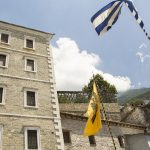The Monastery During The Greek Revolution
After the failed revolt in Chalkidiki in 1821 in which the Athonites participated, the majority of monks abandoned the area, and some monasteries – St Pavlos Monastery among them – were occupied by Ottoman forces. With the exception of two or three monks, the monks of St Pavlos left for the islands of the Aegean (e.g. Skopelos and Hydra), while the artefacts of the Monastery had been taken to the islands of the Ionian Sea (e.g. Zakynthos). When the Ottoman troops left the Athonite peninsula and the area began to return to normal, the Monastery tried to recover its artefacts and to stabilize its economic condition. In fact, it is said that two monks from the Monastery, Sabbas Rosianos and Gerasimos Loverdos, requested help from distant leaders, including the Russian czars Alexandros I and Nikolaos I, and received financial help to recover the metochia of the Monastery which had been illegally seized by locals.
The decade of 1830 was an important one in the recent history of the Monastery. The monks continued the work of building the new cathedral, a project which had been begun by Anthimos Komnino but had been interrupted by the Revolution and so remained half-finished. In addition, an important event for the Monastery was its return to the system of cenobitic life in 1839, which was formally reinstated by an 1840 edict from the Patriarch Gregorios VI. The first Abbot was Stefanos, a hieromonk and Prior of the Dionysios Monastery.
1839 was also the year that the construction of the new cathedral was completed, and it was consecrated in 1844. The central figure in all the efforts relating to the renovation was the Archimandrite Sofronios Kalligas. The Archimandrite not only helped to complete the project, but was also appointed as Abbot, and served from 1843-1882, a long period of time, with some brief intervals of interruption. The new cathedral was inaugurated so as to celebrate its feast on the same day as that of the the Presentation of Christ (Υπαπαντής) because, according to tradition at the Monastery, the founder St Pavlos had dedicated the first small church in the name of the Presentation.
The renovation projects continued during the following years. Unfortunately, a particularly-destructive fire occurred during the night of 3rd-4th January 1902. A large part of the southwest wing of the Monastery complex and about 220 Slavic codices were destroyed, leaving a large gap in the records of the Monastery’s history.
Just as the Ottoman conquest of 1423/4 had found the Monastery in a phase of restructuring, so did the 1912 liberation of the peninsula by the Greek army. It had a new, large cathedral, along with a spacious monastic compound ready to receive new monks. Already by the 1830s decade, monks from Kefallonia had started to arrive. From that time up until the second half of the 20th century, they would comprise the majority of Greek monks of the brotherhood at the Monastery.
After 1922, the arrival in Greece of the refugees from Asia Minor led to the loss of the Monastery’s metochia in Chalkidiki, since the properties were taken over by the Greek state to provide lands for the refugees, a policy which affected all the Athonite monasteries. Today, the estate of the Monastery is comprised of real property in urban areas, which generate income used by the Monastery for its maintenance. The region south of Athos which the Monastery holds rights to is rich in timber, and provides an important additional income to the Monastery.
In addition to the figures mentioned above who played an important role in the history of the Monastery, the Archimandrite Serafeim Padazatos – who served as Abbot between 1910-1932 and 1934-1960 – must be included. Among his other contributions, he published the periodical St Pavlos of Xeropotamos for decades, a unique attempt by the Monastery to make its history known to a wide reading audience, thereby also benefiting Mt Athos as a whole.

